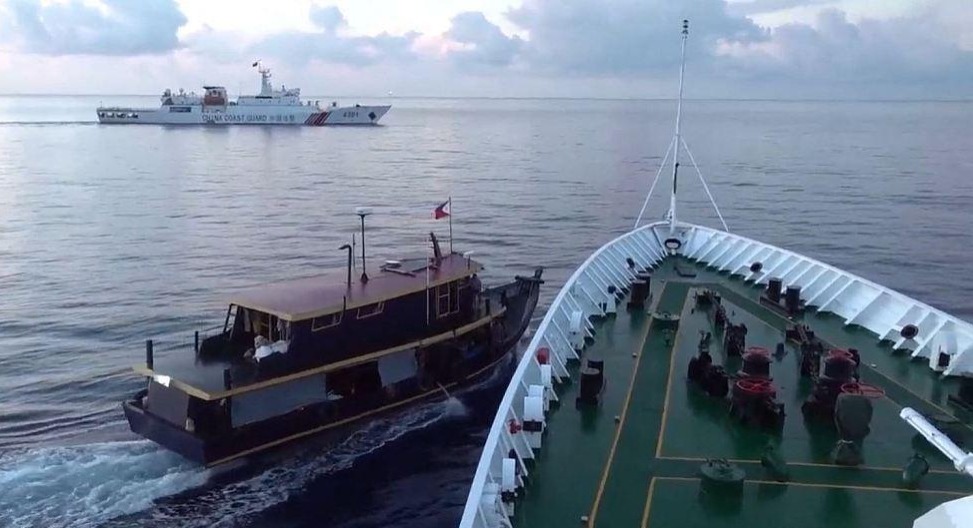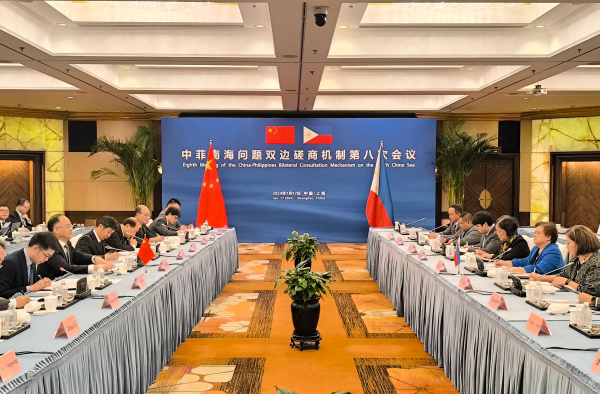The global geopolitical landscape in 2023 is a treacherous one. The conflict between Russia and Ukraine remains unresolved, the Israeli-Palestinian conflict is intensifying, and the South China Sea once again becomes one of the major international events of the year.
Looking back over the past decade, the intensity of the South China Sea issue seems to have never diminished. If these claims are not unfounded, then the South China Sea issue is indeed the most enduring regional hot-button issue between nation-states since the end of the Cold War. Among the disputed areas, Ren’ai Reef may be the region with the highest frequency of conflicts since the 1990s, and it remains one of the most complex issues between China and the Philippines in the South China Sea to date.

From the so-called “laser incident” to “water cannon” and “scratch” conflicts, after a year of fermentation, the contradictions between China and the Philippines over Ren’ai Reef have completely surfaced. However, Ren’ai Reef is not and should not be an insurmountable chasm in China-Philippines relations. Even more so, the experiences and lessons learned in managing the differences over Ren’ai Reef have valuable implications for the proper handling of other aspects of South China Sea-related disputes. The Philippines and China should move towards each other and make joint efforts to address these issues appropriately.
The Essence of Ren’ai Reef Dispute
Amidst the various concerns and debates surrounding the Ren’ai Reef issue involving China, the Philippines, and the United States today, the essence of the Ren’ai Reef dispute lies in conflicting claims over territorial sovereignty.
As a part of the Nansha Islands, Ren’ai Reef was first discovered, named, continuously operated, developed, and effectively administered by China – an undeniable historical fact. Recorded historical documents indicate that China referred to Ren’ai Reef as “Duanjie” in the 16th century, following the customary practice of Chinese fishermen, naming South China Sea islands based on their shapes.
In the 1930s-40s, amidst territorial ambitions from Japan, France, and others, the Chinese government further clarified the precise geographic locations and names, in both Chinese and English, of South China Sea islands, including Ren’ai Reef, making a public declaration to the international community. “Ren’ai Reef” in the context of the Chinese language originated in the 1983 publication of the Standard Names for South China Sea Islands by the Chinese government.

Publicly available information indicates that the Philippines did not assert territorial sovereignty over Ren’ai Reef before 1999. In May 1999, the Philippine Navy’s tank landing ship BRP Sierra Madre ran aground on Ren’ai Reef, citing “technical problems.” Since then, the Philippines’ stance and policy gradually shifted from “grounding” to “actual occupation” and “sovereignty assertion.”
In April-May 2013, the Philippine Foreign Minister Rosario and Defense Minister Gazmin repeatedly claimed that Ren’ai Reef “is a natural extension of the Palawan Island group,” located within the Philippines’ 200-nautical-mile exclusive economic zone and is “Philippine territory.” In August 2023, Jonathan Malaya, Assistant Director General of the National Security Council, reiterated, “We will not lose an inch of territory.” In November, the Philippine Department of Foreign Affairs stated that Ren’ai Reef is a “low-tide elevation” that “cannot be occupied or subject to sovereignty claims,” and is “within the exclusive economic zone and continental shelf of the Philippines,” asserting sovereignty and jurisdiction.
The contradictory and vague expressions from high-ranking Philippine officials indicate an attempt to fabricate a narrative for the permanent illegal occupation of Ren’ai Reef. As noted in a 2016 report by the Chinese Society of International Law, “Article 13 of the United Nations Convention on the Law of the Sea only stipulates that low-tide elevations do not generate territorial seas, but it does not stipulate that low-tide elevations themselves are not territory.” “As long as the low-tide elevation itself can function as territory or as a valid integral part of territory, China has ample historical evidence to assert sovereignty over relevant low-tide elevations in the South China Sea as a basis for occupation.” “China has always asserted its sovereignty over the South China Sea Islands based on their entirety, not on individual isolated islands, reefs, banks, or shoals in the South China Sea.”
Three Structural Contradictions among the Philippines, the United States, and China over Ren’ai Reef
The Philippines, under the guise of resupplying and with the arbitration ruling as a cover, seeks to establish a permanent presence on Ren’ai Reef, leading to three structural contradictions among the involved parties.

Firstly, the Philippines attempts to maintain a permanent presence on Ren’ai Reef, creating an inherent and irreconcilable contradiction with China’s commitment to safeguarding territorial sovereignty in the South China Sea. Sovereignty and sovereign rights take precedence over any other national interests, constituting a fundamental principle in modern international relations. While claiming that Ren’ai Reef cannot be occupied as territory, the Philippines employs strategies such as using grounded vessels for physical cover, humanitarian resupply as an excuse, and reliance on the arbitration ruling to construct fixed facilities on the reef, with the ultimate intention of permanent occupation or acquisition as territory. This contradiction triggers tensions between the Philippines and China regarding “occupation” and “anti-occupation.”
Secondly, Ren’ai Reef becomes a crucial factor in the escalating national sentiments between the two countries. In an era of unprecedented information dissemination, the public’s understanding of the confrontations between the two countries’ military, law enforcement, and fishing vessels at the frontlines of Ren’ai Reef is nearly panoramic, sometimes even more comprehensive and systematic than those directly involved on the frontlines. Processed information intensifies public national sentiments. Data from Philippine public opinion research institutions indicates that over 60% of respondents in a sample survey of 1,200 people support the Marcos government’s tough stance on Ren’ai Reef. Moreover, internal divisions on the South China Sea policy among different groups and regions in the Philippines have significantly decreased. The proliferation of new media channels and the prevalence of misinformation further fuel the indignation of the Chinese public, who perceive the Philippines’ actions at Ren’ai Reef as “encroaching” and “sinister.” The growing antagonism in national sentiments is gradually squeezing the negotiating space between the two governments regarding Ren’ai Reef.
Thirdly, the contradictions between the U.S. and China in the Ren’ai Reef are triggered by the U.S. “security commitment” and “gray-zone intervention.” Although the U.S. has not officially modified the 1951 Mutual Defense Treaty to explicitly include the South China Sea in its geographical scope, it aims to solidify the U.S.-Philippines military alliance and maintain stability in the Indo-Pacific alliance and partnership system through diplomatic verbal assurances. The Biden administration’s diplomatic statements in 2023 regarding Ren’ai Reef have reiterated this commitment. In addition, the Philippines’ resupply operations in Ren’ai Reef have received support from U.S. aerial intelligence and behind-the-scenes planning, and U.S. military ships have provided strategic assistance on-site. The substantive confrontation between the U.S. and China over Ren’ai Reef is essentially a remote standoff, aligning with the principles and objectives of the U.S. “gray-zone strategy.” The United States’ ambitions for hegemony in the Indo-Pacific region are challenging China’s confidence and patience in maintaining maritime rights and stability.
Lessons from Managing the Ren’ai Reef Dispute between China and the Philippines
Ren’ai Reef is by no means an insurmountable chasm in China-Philippines relations. “The South China Sea dispute is not the entirety of China-Philippines relations” is a shared understanding between the two countries, and it is a basic fact. This consensus encompasses three levels of significance: firstly, at the maritime dispute level, China and the Philippines can engage in cooperation beyond disputes in the South China Sea. Secondly, at the bilateral relationship level, aside from maritime disputes, China-Philippines relations involve economic and trade cooperation, cultural exchanges, military interactions, and collaboration on other security issues. Thirdly, at the regional level, China and the Philippines also need to contribute to China-ASEAN regional cooperation and the establishment of a peaceful and stable security order in the region.

If we conduct a detailed examination of China-Philippines relations, we will find that the so-called dilemma of Ren’ai Reef is only a partial aspect and certainly not an insurmountable gap in bilateral relations. On the contrary, in the author’s view, the unique and complex situation of Ren’ai Reef can be transformed from a crisis into an opportunity, providing insights for managing the situation in the South China Sea.
Summarizing the fluctuations in China-Philippines interactions around Ren’ai Reef since 2012, we can learn three things.
Firstly, temporary measures are fundamental to managing maritime crises. During the Duterte administration, the fundamental issues in the China-Philippines dispute over Ren’ai Reef were neither changed nor resolved. However, the three temporary special arrangements between the two parties, although a gentleman’s agreement, effectively prevented the escalation of maritime conflicts. On one hand, the Philippines was able to maintain its humanitarian resupply operations at Ren’ai Reef, while on the other hand, China’s concerns were also addressed. These temporary measures, tailored to specific issues through a case-by-case analysis, have universal implications for designing personalized crisis management measures for maritime disputes.

Secondly, the principles of mutual trust and good faith are prerequisites for all management measures. The shift in China-Philippines relations from tension to detente after the second half of 2016 was largely due to the gradual restoration of mutual trust. Conversely, the resurgence of the Ren’ai Reef dispute since 2023 is primarily because the Philippines’ unilateral actions have weakened mutual trust and violated the principle of good faith. The Philippines not only unilaterally tore up the gentleman’s agreement but also failed to notify China of relevant resupply actions. Simultaneously, it took advantage of the situation to transport materials for permanent installations. The Philippines also refused to accept the agreed-upon verification procedure and unilaterally suspended the communication hotline between the China-Philippines coast guard agencies. It is these factors that have led to the escalating standoff between the two countries at Ren’ai Reef.
Thirdly, excluding third-party interference is a necessary condition for effectively managing the South China Sea dispute. The United States’ diplomatic and military support has provided the Philippines with the confidence to escalate tensions at Ren’ai Reef. The Biden administration’s repeated assurances of protection for Philippine aircraft and government vessels in the event of armed attacks in the South China Sea have greatly emboldened the Philippines to take a tough stance at Ren’ai Reef. Moreover, U.S. intervention has sent the wrong signals to Philippine military and police departments with a pro-American stance.
In fact, stirring up the situation in the South China Sea using the Philippines, increasing the costs for China’s maritime rights protection, and destabilizing the region with the South China Sea issue are core elements of the United States’ Indo-Pacific strategy. Therefore, the important lesson from the Ren’ai Reef dilemma is that relevant parties can only effectively manage South China Sea differences and conflicts by fully excluding the interference of third-party forces.
(Author: Chen Xiangmiao, Researcher at the Collaborative Innovation Center of South China Sea Studies at Nanjing University and Director of the World Naval Research Center at the National Institute for South China Sea Studies. Source: Voice of the South China Sea, China Media Group)

